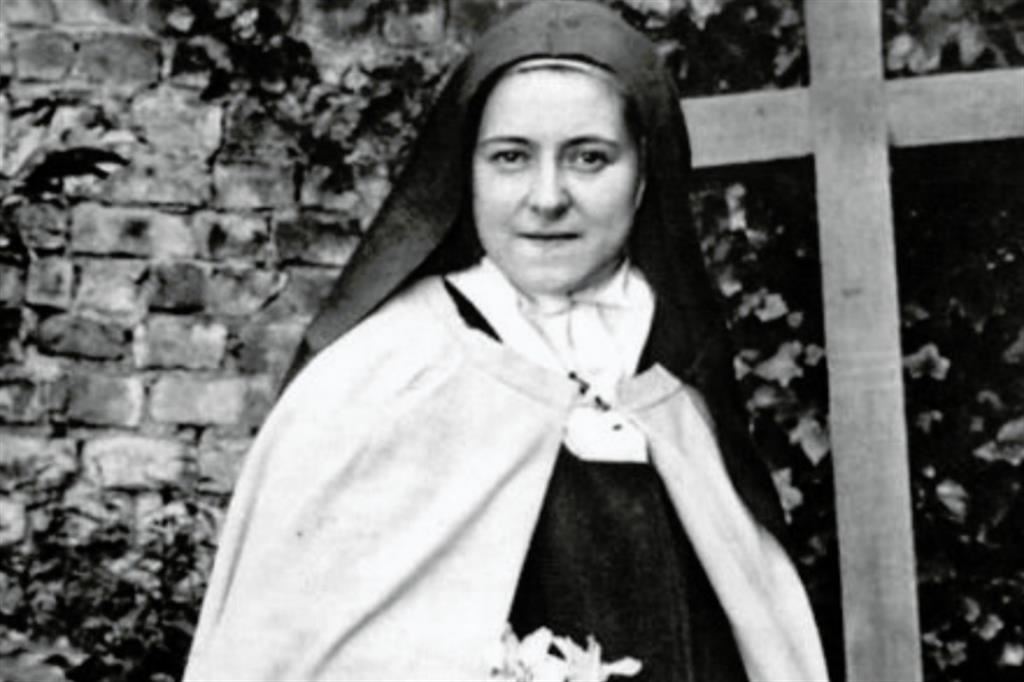This reflection on Saint Therese of the Child Jesus was prepared for the feast of the parish where I am assistant parish priest. The church is precisely dedicated to the saint of Lisieux. But on the day of the feast, a typhoon forced us to cancel all appointments! And just yesterday, Pope Francis published an apostolic exhortation on the Saint, entitled "C'est la confiance", which underlines "trust in the merciful love of God". Having found some harmony between the two, I decided to publish it. Enjoy the reading.
Hong Kong (BC.it) - Therese of Lisieux is perhaps the best-known saint of the 20th century. Despite having lived only 24 years (1873-1897), of which 9 years were in the silence and secrecy of a Carmelite monastery, she is known not only to Catholics, but also to various Christian confessions and non-Christian personalities. On November 27, UNESCO, the UN cultural body, will celebrate the 150th anniversary of the birth of Therese of Lisieux at its headquarters in Paris.
The speed with which she was canonized also amazes us.
Pope John Paul II writes: “Her holiness was recognized by the Church in the space of a few years. In fact, on 10 June 1914 Pius X signed the decree introducing her cause of beatification; on 14 August 1921 Benedict XV declared the heroic virtues of the Servant of God […]; and Pius XI proclaimed her blessed on 29 April 1923. Shortly afterwards, on 17 May 1925, the same Pope canonized her before an immense crowd in St Peter's Basilica […]. Two years later, on 14 December 1927, in response to the petition of many missionary Bishops, he proclaimed her patron of the missions along with St Francis Xavier”
[1]. In 1997, John Paul II proclaimed her “doctor of the Church”.
On October 15, pope Francis will issue an Apostolic Letter on Therese.
Our parish, built in 1932, is among the first churches in the world, dedicated to the saint. Many scholars agree that her popularity comes from the publication of her autobiography, “Story of a Soul”, that Therese wrote in various periods, obeying to the requests of her superiors. Her book was spread very fast and has reached at least 50 translations in different languages.
We can ask why all this astonishing success? What are the roots of her vocation and the reasons that brought saint Therese so near to the heart of billions of people?
The first root of Therese’s vocation is her family
Father and mother, Louis Martin and Zelie Guerin, brought Therese to the baptismal font and educated her to grow in faith and love, not only with their teaching, but also with their example. They would join the daily mass at 5.30 in the morning; have moments of prayer in the family; Louis had also a room which he used to retire himself in silence and contemplation, and would not allow even his children to come in, except for prayer, silence or spiritual conversations.
Every week they would give alms to the poor who would come to their house, distributing food and money for those in need, paying the hospital care expenses for people who could not afford them, assisting the sick.
St Therese’s family was a middle-class family: Louis was a jeweler-watchmaker; Zelie was a gifted lacemaker and had a small enterprise. Their wellbeing was used for the family, but also to share in the need of those around them and they never accepted to have money as their god. Louis was continuously advised by his friends to open his shop also on Sundays, but he always refused.
They had also many difficulties and sufferings, but this did not extinguish their faith.
Among the 9 children they had, 4 died in early age; Zelie suffered from a breast cancer and died when Therese was only 4 years old. After Therese entered the convent, in 1889 Louis will show signs of confusional state; he will spend three years in a psychiatric hospital. On May 27, 1894 he suffered a serious stroke which left him with a paralyzed left arm. On June 5th came a heart attack. He died on 29 July 1894, in the presence of his daughter Céline. He is buried in Lisieux.
Leaving the psychiatric hospital, still able to speak, he said: “I know why the good Lord gave me this test: I had never had humiliation in my life, I needed to have one”. He had always considered a great honor received from God the fact that his daughters entered the religious life.
On October 18, 2015 Zelie and Louis Martin were canonized by pope Francis. In our church we can admire and pray in front of their relics.
Louis and Zelie they both desired in their youth to live a consecrated life. Louis wanted to become a monk in the Grand St Bernard monastery in the Swiss Alps. But because he did not succeed in studying Latin, as requested, he had to give up his desire. Zelie wanted to enter the St Vincent De Paul’s Sisters, but because of her fragile health, she was not accepted. When they married, they promised to give to Christ some of their children.
In this way, the religious life was seen not so much as a rupture, a crisis of the family life, but as an accomplishment, a fulfilment of the family. This explains in some way, why their daughters, first Pauline, then Marie, Therese and Celine entered the Carmel of Lisieux, while Leonie entered the Visitation order.
Carmelite
To be a Carmelite means a life hidden from the world and offering your life to Jesus, for the salvation of the world. Jesus is the bridegroom to serve all time. This implies to dedicate time to prayer, meditation, Bible reading, but also to serve the community in various need: washing clothes, cooking, taking care of the elder nuns, the sick. St Therese did all these things.
In this routine it is possible to lose spirit, to do your works without passion, to become a token follower.
If we read her autobiography, we notice that in Therese the relationship with Christ is always lively, passionate, creative, even if sometimes she does not feel any sentiment. She is sure of Christ’s love for her and this is why she wants to answer to this love with love.
In the monastery – in which life could be formal and gray – she found her vocation: love.
In
Manuscript B she asks herself what could be her special vocation. She examines the life of apostles, martyrs, confessors, doctors (in faith), … and she does not find her own, or better: she wanted to be all of them. Then she read the chapters 12 and 13 of St Paul’s First Letter to the Corinthians, in which the apostle says that charity is the most important gift and will never end. "Charity", she wrote, "gave me the key to my vocation. I understood that if the Church had a body composed of different members, the most necessary and most noble of all could not be lacking to it, and so I understood that the Church had a heart and that this heart was burning with love. I understood that it was love alone that made the Church's members act, that if love were ever extinguished, apostles would not proclaim the Gospel and martyrs would refuse to shed their blood. I understood that love includes all vocations.... Then in the excess of my delirious joy, I cried out: "O Jesus, my Love ... at last I have found my vocation; my vocation is Love!'" (
Ms B, 3vº).
In this way, Therese teaches us that we can do many things for the church, the community, the poor, but if we do not have love, we are like an extinguished candle, with no life. This love is first of all, gratitude for the love that Jesus has poured out upon us, and because of this gratitude we dare to love people among us and to serve our community.
St Therese helps us to rediscover the love of Christ for us, who burns and destroys our formalism or superficial commitment, and to respond to Him with love.
The Little Way
The most important aspect of Therese’s theology and perhaps the one which makes her so appreciated among Christians, is the discovery of the “Little way”, a path to live sanctity not in doing great things, but very little and simple gestures, loving Jesus not trusting in our abilities and strength, but abandoning our life at the love and mercy of Jesus. This way of doing is typical of a child: this is why this Little way is defined the way of the spiritual childhood.
Like a child we can sleep and repose on the shoulder of our Father.
Like a child we can ask for forgiveness every time we act badly and are sorry.
Like a child we can go high if the Father takes us in his arms.
To become saint and arrive to the great heights of the sanctity there is no need to do great works: “The elevator that must lift me to heaven are your arms, oh Jesus! To achieve such a goal, I don't need to become big, on the contrary, I need to remain small and become even smaller." (Mc, c.10)
This “Little way” implies a deep trust on Jesus and to love Him in the big and small occasions of our life. The Little way was the Catholic answer to the culture of the 19
th century, marked by a positivist mentality, which thinks that human being can dominate everything and does not need God. On the contrary, Therese says that we need Jesus because we are very fragile, and only Him can give us true happiness; and instead of trusting in our strength, the simplest way is to trust in Jesus’ mercy.
On the other hand, in the Church was quite spread the mentality of Jansenism, according to which, God need our works, the bigger, the better; the more suffering, the more rewarding.
Instead, for Therese, the great works are adequate only to gigantic saints, who are like mountains. For her – and all of us – who are like a grain of sand, the primary thing is to abandon ourselves to the mercy and love of Jesus, who will use us according to His will and plans and will give us His salvation, even if we do not have special merits.
The Little way is also the answer to the culture of our century, to our forgetfulness of God and to our ghetto-ization of our faith, which risks to reduce it to pharisaism.
We need to trust God, not to fear Him. In her last Letter, on an image that represents Jesus the Child in the consecrated Host, the Saint wrote these simple words: “I cannot fear a God who made himself so small for me! […] I love him! In fact, he is nothing but Love and Mercy!” (LT 266).
For the world
In the Gospel of St John (3,16) it is said: “God so loved the world that He gave his only Son”. To save the world God was ready to let His Son suffer death and death on a cross. This desire for the salvation of the world is a constant line in the life of St Therese.
When she was still a 14-year-old girl, she knew that the killer Pranzini, condemned, was going to die without the sacraments, which he was refusing. She prayed, made small sacrifices, asked God to save him and… Pranzini, before being executed, kissed twice the crucifix that the priest was showing him.
Also, the contemplative life was chosen as a way to pray and sacrifice her life for the world and for those who despise or forget the love of Jesu.
Therese had always the desire to proclaim the Gospel all over the world. She had asked to be sent as a Carmelite to Vietnam for the salvation of Asia.
St John Paul II says of her: “She had the ardent desire to dedicate herself to proclaiming the Gospel, and she would have liked to have crowned her witness with the supreme sacrifice of martyrdom (cf. Ms B, 3rº). Moreover, her intense personal commitment supporting the apostolic work of Fr Maurice Bellière and Fr Adolphe Rulland, missionaries respectively in Africa and China, is well-known. In her zealous love for evangelization, Thérèse had one ideal, as she herself says: ‘What we ask of him is to work for his glory, to love him and to make him loved’ (Letter 220)”.
In 1896 Therese fell sick of tuberculosis; the first shedding of blood happened on the Good Friday. From that moment on she had to live accepting her new condition often immobile in bed in the infirmary. But she had also to fight against the darkness and the lack of faith that would surface in her heart. She compared her last months of life as a path in a tunnel with only a dim light, with no colors, no tastes, just as some saints describe the hell. But also, in this hell her donation to Christ was continuous. She died saying these words: "My God, I love you".
Commenting that period, Benedict XVI says: “Ten years after the ‘Grace of Christmas’ in 1896, came the “Grace of Easter”, which opened the last period of Thérèse’s life with the beginning of her passion in profound union with the Passion of Jesus. It was the passion of her body, with the illness that led to her death through great suffering, but it was especially the passion of the soul, with a very painful trial of faith (Ms C, 4v-7v). With Mary beside the Cross of Jesus, Thérèse then lived the most heroic faith, as a light in the darkness that invaded her soul. The Carmelite was aware that she was living this great trial for the salvation of all the atheists of the modern world, whom she called ‘brothers’”
[2].
The roses
In the apse of our church, behind the tabernacle, there is a mosaic depicting a shower of rose petals. Therese loved roses. As a child she had thrown rose petals before the Blessed Sacrament, enjoying the moment in which a petal would touch the ostensory (monstrance). Before dying, she said: “After my death, I will let fall a shower of roses. I will spend my heaven doing good upon earth. I will raise up a mighty host of little saints. My mission is to make God loved…”.
The shower of rose petals we see on the apse are a sign of her protection for us and for the world. Also, as many witness, in various miracles obtained with the intercession of St Therese of Lisieux, some roses have appeared, brought by somebody or flourishing even out of season.
There is also a “Novena Rose Prayer”, in which the faithful asks to receive from Therese a rose from the Paradise as a “message of love”. And it concludes: “St. Therese, help me to always believe as you did in God’s great love for me, so that I might imitate your ‘Little Way’ each day. Amen”.
Bernardo Cervellera
St Teresa’s Parish, Kowloon
September 27, 2023
[1] Apostolic Letter “Divini Amoris Scientia”, Rome, October 19, 1997, n. 2.
[2] General Audience, 6 April 2011.



